
© Dave Morgan. (Click image for larger version)
Bolshoi Ballet
The Flames of Paris
London, Royal Opera House
17 August 2013
Gallery of Pictures by Dave Morgan
www.bolshoi.ru/en
Details of the Bolshoi London season
Alexei Ratmansky’s Flames of Paris is a lot like Matthew Bourne’s Swan Lake. Both are commentaries on the original ballets of the same name, set to the original scores but giving the stories a different slant. Both send up the balletic conventions of the period and mock the monarchies they depict on stage. Both productions send a shiver down your spine as you finally register how tragic their endings are.
The Flames of Paris was commissioned in 1932 for the fifteenth anniversary of the Russian Revolution. Stalin had decreed that the masses should be inspired by ‘relevant’ ballets instead of the Swan Lakes they perversely preferred. They should be able to recognise the way ordinary people danced instead of being dazzled by Petipa’s pyrotechnics. Vasily Vainonen’s Flames was the first time folk dances had been given artistic equality with classical ballet, and the first time the corps de ballet was made as important as the soloists. Based on a French novel by Félix Gras, the scenario told how the oppressed masses rose up against their decadent rulers in the cause of liberty, fraternity and equality. The ballet duly won the Stalin Prize.
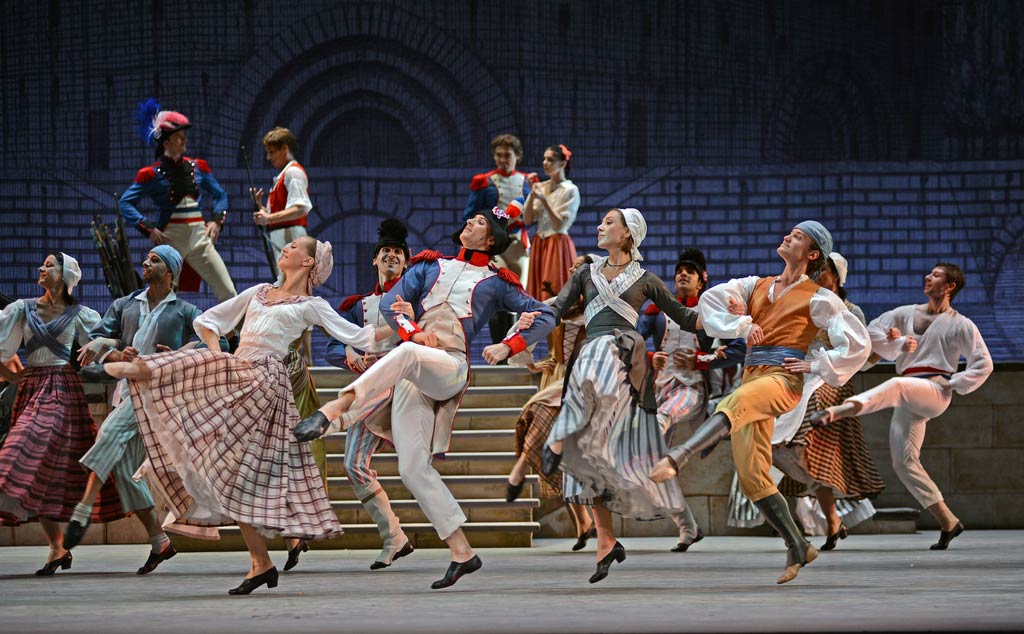
© Dave Morgan. (Click image for larger version)
Mikhail Messerer has recently revived Vainon’s production for the Mikhailovsky Ballet, staying as close as possible to the 1932 scenario and choreography (DanceTabs review). Ratmansky, while he was artistic director of the Bolshoi Ballet, took his own approach in remaking The Flames of Paris in 2008. Instead of endorsing revolutionary fervour, he warns of the inevitable consequences. He adapted the scenario to place more emphasis on individuals caught up in the heady revolt. He added a character, aristocratic Adeline, who pays the price for her conversion to the cause.
She is the daughter of a depraved Marquis, who assumes he can have his way with any woman he fancies. In the first scene, he attempts to rape Jeanne, the peasant girl heroine, who escapes with the aid of her brother, Jerome. He is beaten up by the Marquis’s henchmen and thrown into a prison cell. Adeline rescues him, and they fall in love. She has to travel to Versailles with her father, while Jerome and Jeanne join a battalion of revolutionaries on their way from Marseilles to Paris. Jeanne has fallen for the manly charms of one of the soldiers, Philippe.
The second scene takes place in the royal palace of King Louis XVI and Marie Antoinette. The court is entertained by a ballet, Rinaldo and Armida, starring Mireille de Poitiers and Antoine Mistral. At the end, the drunken Marquis makes advances to Mireille, to the disgust of his daughter. When the Marseillais troupe passes by, Adeline joins them.
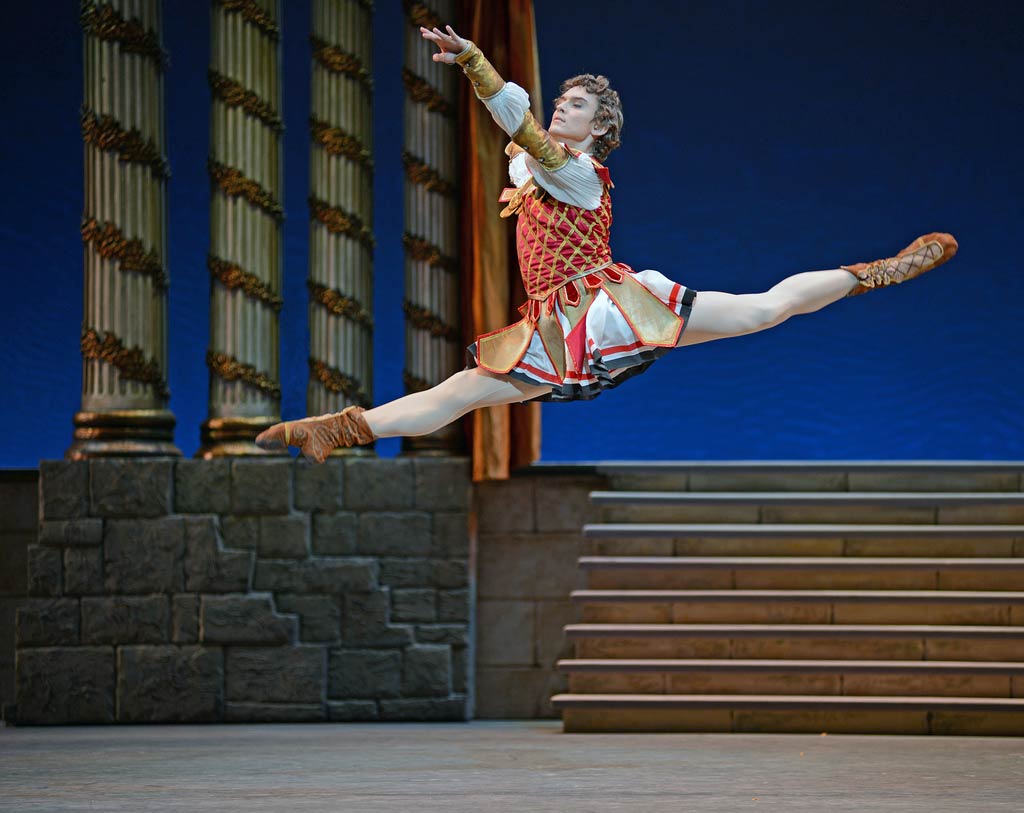
© Dave Morgan. (Click image for larger version)
In the next act, a revolutionary crowd is carousing in the Champ de Mars in Paris. Adeline and Jerome are reunited. The mob seizes the Tuileries Palace, where the royal family was sheltering. By scene two, a Republican government has been installed. Mireille and her partner perform, yet again, for the new regime. Jeanne and Philippe, the first newly-weds of the Republic, celebrate with a joyous pas de deux in front of the guillotine. The Marquis is dragged in to be executed. Adeline is exposed as an aristocrat and beheaded at the urging of the mob. While Jerome mourns, Jeanne and Philippe join the triumphant populace marching towards the audience to the thumping rhythms of the revolutionary song, Ça ira – ‘It’ll be fine’.
No, it won’t. Jeanne and Philippe have succumbed to mob mentality. Jerome has failed to save the woman he loved; his faith in revolutionary ideals has been betrayed. As French, Russian, Iranian, Arab children of revolution know, violence begets cruelty and repression. Ratmansky’s murderous masses advance on the audience in a very different light from Vainonen’s merry proletariat. He had to please Stalin, or else. Dancers who had performed for the Russian Imperial court survived by dancing for the Bolsheviks; the Paris Opera Ballet performed for the Nazi occupation. Sauve qui peut.

© Dave Morgan. (Click image for larger version)
I had first seen Ratmansky’s Flames of Paris in the cinema, in a live relay from the Bolshoi theatre in 2010 (now a DVD). Thanks to the ecstatic response of the Russian audience to Natalia Osipova and Ivan Vasiliev as Jeanne and Philippe, I wasn’t sure if I had rightly interpreted Ratmansky’s intentions. So I booked to see the Saturday matinee cast at the Royal Opera House: Ekaterina Shipulina as Jeanne, Vladislav Lantratov as Philippe, Anna Rebetskaya as Adeline, Denis Savin as Jerome.
Sure enough, it’s evident from the start that all four are naïve youngsters seduced by revolutionary fervour. The Marseillais soldiers strut and pose like heroic Soviet workers on propagandist posters, heads thrown back, arms upthrust. Lantratov’s Philippe is so bold and handsome that no wonder Shipulina’s Jeanne is smitten. She and Savin as her brother literally jump up and down in excitement. Ratmansky’s choreography in the first scene seems to be referencing his Bournonville experience with the Royal Danish Ballet: bouncy steps, lots of beats, swift petit allegro for Jeanne and Adeline. Shipulina dances with classical precision, always passing through fifth position, however carefree she appears in the first scene.
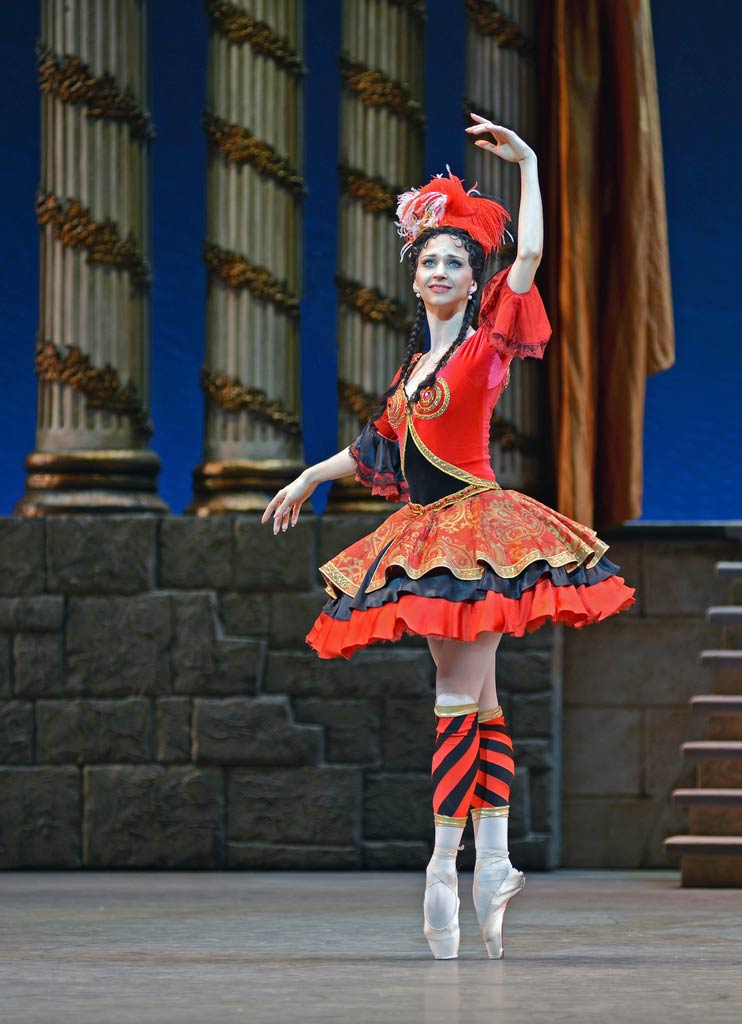
© Dave Morgan. (Click image for larger version)
In the royal palace scene, Ratmansky has fun sending up French courtly ballet conventions in Rinaldo and Armida, much as Matthew Bourne does in his comic entertainment for the Royal court in Swan Lake. Anna Tikhomirova as Mireille de Poitiers is winsome in a preposterous costume; Denis Rodkin is blank and beautiful as Antoine Mistral, bored silly in Rinaldo’s Grecian tunic and blond wig. The choreography is witty and tricky, with a touch of Ashton. Trouble is, audiences looking for narrative rather than ingenious pastiche become restless at the length of the divertissement. It’s very funny, involving a reproachful phantom bride in white and six fiendish Furies in black. Rinaldo’s death and Armida’s regret are perfunctory, hurried over so that the self-satisfied pair (both very fine dancers) can milk their bows.
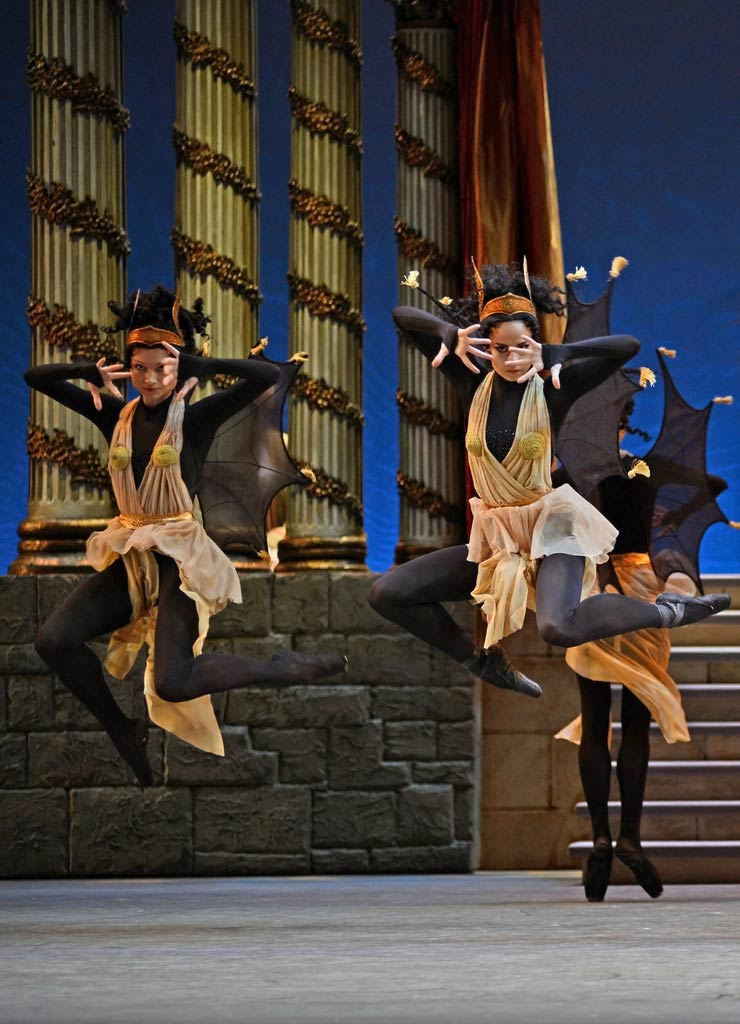
© Dave Morgan. (Click image for larger version)
King Louis and Queen Marie Antoinette, who couldn’t be bothered to watch the performance, arrive to receive the homage of the court. The King, in the person of Denis Medvedev, is such a smugly bad dancer that he almost deserves his impending fate. His courtiers are far better than he is, little does he know it, though they too are doomed.
In Act II, the crowd of revolutionaries entertain themselves with regional dances to folk music. Boris Asafiev’s score is largely composed of popular tunes of the revolutionary period (with recorded singing of the Marseillaise anthem). In place of the purely character dances Vainonen choreographed, Ratmansky includes balletic enchainements for the principals, who have to change their footwear to accomplish them. His sole romantic pas de deux is for Adeline and Jerome, to dreamy music that contrasts with the boisterous goings-on around them, accompanied by pounding drums. Savin is very touching as Rebetskaya’s besotted, overawed suitor.
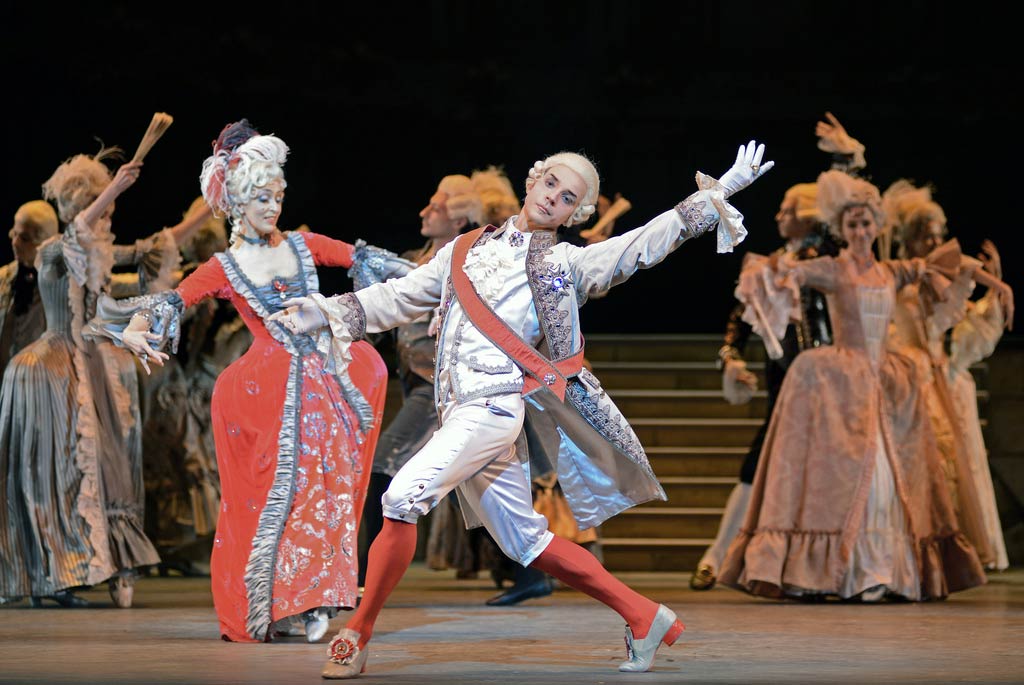
© Dave Morgan. (Click image for larger version)
The wedding pas de deux for Jeanne and Philippe is the virtuoso duet Vainonen choreographed, often given as a showcase at Russian galas. Lantratov performs the male fireworks with unforced elegance, leaping high and winding his multiple pirouettes to a controlled finish. He remains a danseur noble even while he animates the spectators on stage and in the audience. Shipulina is a Giselle, dancing innocently for pleasure, rather than a flamboyant Kitri. They don’t take the risks that Vasiliev and Osipova do, exciting the audience to a frenzy; instead, they keep the pas de deux in proportion to the rest of the ballet.
Mireille and Mistral have taken part in a victory parade, dressed, like their retinue, in the pseudo-classical Republican garments that Jean Louis David painted, glorifying the Revolution. Heroically, Mireille brandishes a tricoleur banner: she’ll oblige, come what may. High-flying one-handed lifts look like an ironic parody of Soviet choreography, though they may be Vainonen’s work. Ratmansky is nudging the audience into realising that revolutionary celebrations aren’t as whole-hearted as they seem, even before the guillotine arrives. Nonetheless, the ending comes as a bloodchilling shock. Savin’s Jerome is effectively trampled underfoot as the mob surges forward, indifferent to individual agony.













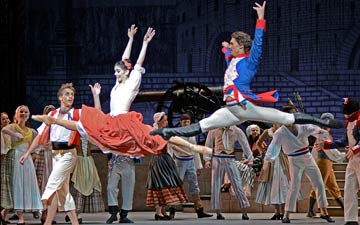

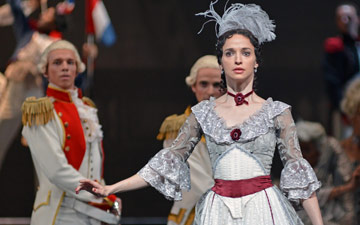
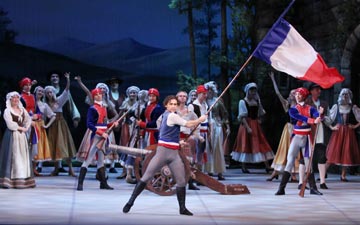
Wonderfully evocative review of the performance I saw. Thanks!
Wonderful piece, and makes me regret even more that I wasn’t in London to see this. I’ve only seen the ballet on video, but even there, it seemed so clever and full of life and infinite sadness.
Love it !!!